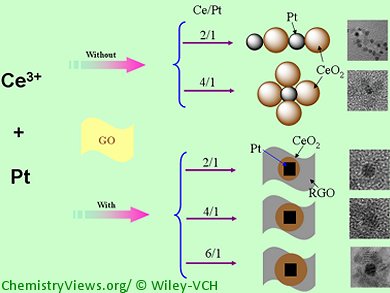Recently, a hybrid substrate to support nanoparticle (NP) catalysts has been developed. It uses metal oxides and reduced graphene oxide (RGO) nanosheets as co-supports. The rigid 2D structure of RGO allows the uniform dispersal of the metal oxides and acts to stabilize the active centers, thereby increasing their catalytic activities. However, the synthetic method for these new hybrid catalysts, involving in situ growth processes to reduce the noble metal salts on the hybrid structure, causes the formation of non-uniform nanoparticles with large size distributions. This limits the practical applications of such catalysts.
To solve this, H. Zhang and co-workers, Changchun Institute of Applied Chemistry, China, have developed a method for the aqueous synthesis of flowerlike Pt–CeO2 hybrids with controlled Pt shape and CeO2 thickness supported on RGO nanosheets. This was achieved by treating Pt cubes with Ce(NO3)3 in the presence of GO. The density of the CeO2 coating around the Pt cubes depends on the amount of Ce(NO3)3 used. The catalytic activity and recyclability was optimized by controlling the shape and substrate and the stability and catalytic activity of these catalysts. For example, the dehydrogenation of ammonia borane was found to increase with increasing CeO2 shell thickness.
- Graphene Oxide Induced Formation of Pt–CeO2 Hybrid Nanoflowers with Tunable CeO2 Thickness for Catalytic Hydrolysis of Ammonia Borane,
Xiao Wang, Dapeng Liu, Shuyan Song, Hongjie Zhang,
Chem. Eur. J. 2013.
DOI: 10.1002/chem.201300382



